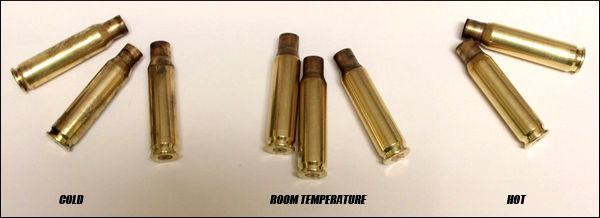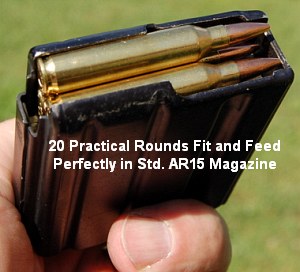August 1, 2021
In this.308 Win Test, 70? F ammo shot 96 FPS faster than ammo heated up to 130.5? F. And the 130.5 F. And the 130.5? F. This is a big difference…
Today is the first of August. This means that most areas of the country will soon experience peak summer heat. Some areas in the West have already seen temperatures exceeding 100 degrees F during matches. Keep your ammo cool in the summer heat. Keep ammo in the shade if possible.
Do not leave ammo boxes out in the sun. Even powders that are “temp stable” can still show significant velocity increases when the ambient temperature reaches 90 degrees or higher. This article will explain how temperature extremes (both cold and hot) can affect bullet velocities. This article explains how velocity differences between very hot and very cold ammo can be quite large.
EDITOR’S NOTE: The Sierra tester doesn’t reveal the brand of powder that was tested. Some powders are more sensitive to temperature than others. Therefore, it is impossible to extrapolate test results from propellants to another. It is nevertheless interesting to observe the actual velocity shift with ammo temperatures variations in a Win.
Written by Tommy Todd, Sierra Chief Ballistician
This story first appeared in the Sierra Bullets Blog
A few weeks back, I was at the Missouri State F-Class Match. It was a two-day event held in the summer. The temperatures were high on one day and even hotter the next. I shot next to a man who was relatively new to the sport. He was shooting a mostly factory rifle and was having fun. However, his scores were not as high as he had hoped and he was having pressure issues with his ammunition. He was forcing the bolt open on several rounds. I met with him during a break and offered some suggestions that helped his situation. He was able to finish without major problems.
He was using factory ammunition, which is normally loaded at higher pressures. This ammunition was fine during “normal” testing but it showed problems during a 20-round string under fire in the temperatures we were competing. My first suggestion was to keep the ammunition out of direct sunlight and to shade it as much possible. My second suggestion was that he not close the bolt on a cartridge before he is ready to fire it. His ammo was in direct sunlight. He was chambering a round while he waited for the target to be pulled and scored. This can take anywhere from a few seconds up to almost a minute sometimes.
This allowed the bullet to absorb chamber heat and build pressure/velocity beyond normal conditions. My recommendations helped to lower the pressures enough to allow the rifle and cartridge work normally.
Experimental Effects of Ammunition Temperature On Velocity And POI
After considering this situation, I decided that I would test the rifle/cartridge combination in the underground Sierra Bullets range. I purchased thirty MatchKing bullets #2275 in.30 caliber 175 grains straight from one of our bullet assembly presses. They were loaded into.308 Winchester ammunition. Unnamed powder manufacturer’s product was used. It is suitable for the.308 Winchester cartridge. Although this load is not the maximum for this cartridge it provides consistent velocities for testing.
I took ten cartridges and put them in a freezer.
I placed ten of them on my loading table. It was cloudy and cool that day so I used a floodlight and stand to simulate the sun heating ammunition.
I used a non-contact laser thermometer to keep track of the temperatures of each ammunition sample.
All three ammunition sets were used in the firing of the rifle at room temperature (70°F). This test was conducted at 200 yards from a return to-battery machine rest. The aiming point was a line drawn on a piece of paper. I fired one group with my scope aimed at that line, then moved the aiming points across the paper from left-to-right for the next groups.
Note that velocity increases with increasing ammunition temperature
The ammunition was taken from the freezer at 2451 fps.
The room temperature ammunition was shot at 2500 fps.
The heated ammunition was shot at 2596 fps.
The rifle’s tune window is quite large as shown by the accuracy at all three pressure/velocity levels. Good accuracy was also achieved across the board. Notice the shift in the point of impact with the third group. If you are shooting at longer distances, there is enough shift at 200 meters to cause a miss. Although the pressure and velocity changed, the load was still far enough from maximum to cause an issue. For example, sticky extraction, flattened primer, ejector marks or flattened primer did not appear. Your results will likely be magnified if you load your ammunition at maximum and then subject it to this test.
This test demonstrated that the temperature of your ammunition at firing can affect pressures, velocity, and point of impact. If you can, test the ammunition in the conditions you intend to use it in. You should also test the ammunition and gun combination to determine if there are any changes. This will allow you to make adjustments as necessary. Personal testing should be done cautiously as some powders and cartridge combinations could become unsafe if conditions change.
Similar Posts
Tags: .308 Win, Ambient Temp, Chronograph, Freezer, Sierra Bullets, Temperarture, Temperature Sensitivity

















